The Fast Break – Victoria
In summary
- Climate drivers in the tropics and far south have been combining for a wetter November, but only in southern Victoria.
- The Pacific Ocean is behaving like a weak La Niña but predicted to decay in January.
- The Indian Ocean appears to be undergoing decay from the negative IOD.
- Ocean temperatures remain very warm in the Coral Sea as an enhanced moisture source.
A wetter than normal November was experienced south of the Great Divide and closer to average in the north. Soil moisture wet up significantly in west and south Gippsland, where moisture probe values are now saturated. Due to the late start to the season many crops failed to utilise their whole moisture profile.
In the Pacific Ocean, weak La Niña temperatures persist at the surface with cooler than normal temperatures in the subsurface. A lack of cloud at the Date Line, a positive Southern Oscillation Index (SOI) and stronger easterly trade winds in the western Pacific indicate this system is coupled. It’s predicted to peak this month and decay in January. This may be kicked off by the passage of the Madden–Julian Oscillation (MJO) when it passes through the western Pacific in coming days.
In the Indian Ocean, weak negative Indian Ocean Dipole surface temperature conditions exist but are rapidly decaying to normality. Stronger westerly winds continue to blow into Sumatra from the eastern Pacific, but pressure and cloud patterns are more in keeping with the phase of the MJO. Models predict this event to be in its decay phase during December.
The Southern Annular Mode (SAM) has been neutral or negative for most of November. This appears to have helped rainfall south of the Divide. Models are divergent as to what the SAM will do post-Christmas.
The MJO was positioned to the north of Australia as a moisture source for much of November but is now moving out to the western Pacific.
Pressure positioning finally moved south to a more normal spring position, but on average Victoria was situated in a low-pressure trough zone due to the passage of many weather systems.
My assessment of 12 climate models for Victoria is neutral for rainfall, but likely to be warmer for the next 3 months.
Soil moisture
Plant-available moisture decile – 28 November 2025
The BoM Australian Water Outlook (AWO) plant-available soil moisture deciles for perennial pasture show drier than average soils in the north and wetter soils along the southern coast and much of Gippsland. Southern Gippsland is much wetter than normal and soil moisture probes there are 100% full.
In the north, water use has stopped as most crops have senesced, but roots have not been able to fully dry the profile, with many probes between 25% and 50% full.
In the last 30 days the Bairnsdale pastures have increased by 34 percentage points from 66% to 100%. The Baynton annual pasture decreased by 35 percentage points from 69% to 34%.
Soil moisture probe data can be accessed in real time at Agriculture Victoria’s soil moisture monitoring website.
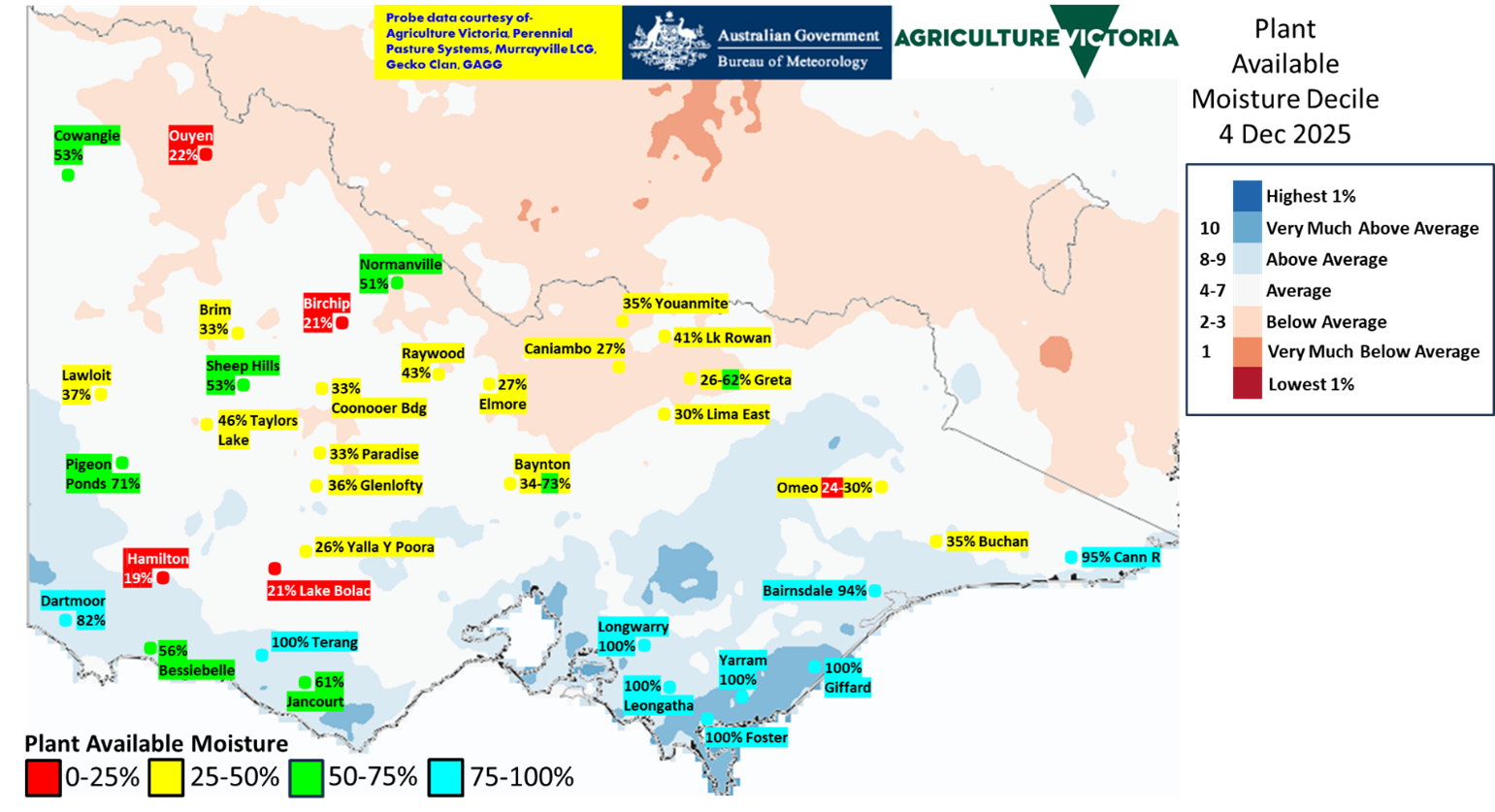
Probes from Agriculture Victoria, Dookie Land Management Group, Gecko Clan, Perennial Pasture Systems, Gippsland Agriculture Group, Murrayville Landcare and Riverine Plains Inc. networks.
Hamilton crop | 19 |
Birchip crop | 21 |
Lake Bolac crop | 21 |
Ouyen crop | 22 |
Omeo crop | 24 |
Yalla-Y-Poora crop | 26 |
Greta summer pasture | 26 |
Caniambo crop | 27 |
Elmore crop | 27 |
Lima East pasture | 30 |
Omeo perennial | 30 |
Brim crop | 33 |
Coonooer Bridge crop | 33 |
Paradise perennial | 33 |
Baynton granite annual | 34 |
Youanmite crop | 35 |
Buchan perennial | 35 |
Glenlofty perennial | 36 |
Greta annual pasture | 36 |
Lawloit lucerne | 37 |
Lake Rowan lucerne | 41 |
Raywood crop | 43 |
Baynton basalt phalaris | 45 |
Taylors Lake crop | 46 |
Normanville crop | 51 |
Cowangie crop | 53 |
Sheep Hills crop | 53 |
Bessiebelle perennial | 56 |
Jancourt perennial rye | 61 |
Greta hill annual | 62 |
Baynton granite phalaris | 73 |
Pigeon Ponds phalaris | 74 |
Dartmoor lucerne | 82 |
Cann River perennial | 95 |
Giffard fodder | 100 |
Bairnsdale perennial | 100 |
Bairnsdale annual | 100 |
Longwarry chicory | 100 |
Longwarry perennial rye | 100 |
Leongatha perennial | 100 |
Yarram prairie grass | 100 |
Yarram ryegrass | 100 |
Terang perennial | 100 |
Foster perennial | 100 |
Model distribution summary for the next 3 months
Predicted rainfall: December 2025 to February 2026
Predictions for December 2025 to February 2026 – the outlook from 12 global model forecasts is neutral for rainfall across Victoria.
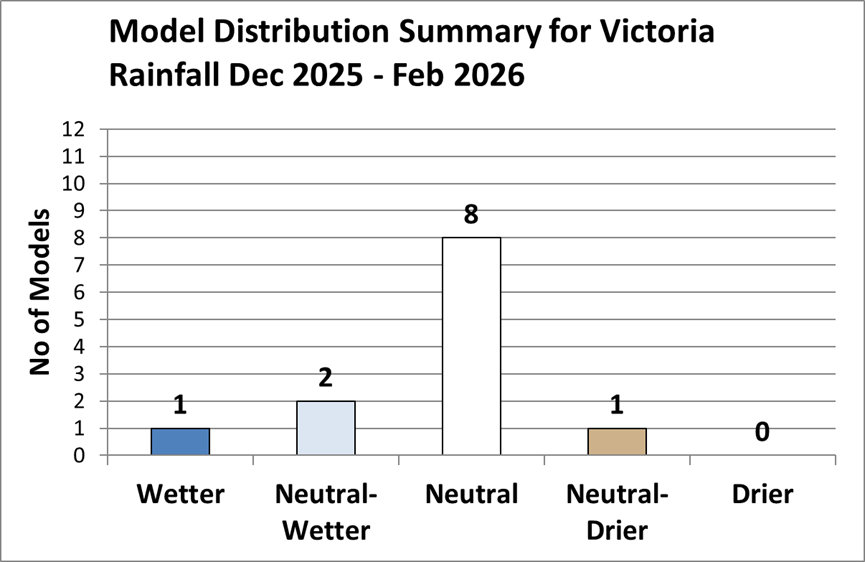
Predicted temperature: December 2025 to February 2026
Predictions for December 2025 to February 2026 – the outlook from 11 global model forecasts is for likely warmer across Victoria.
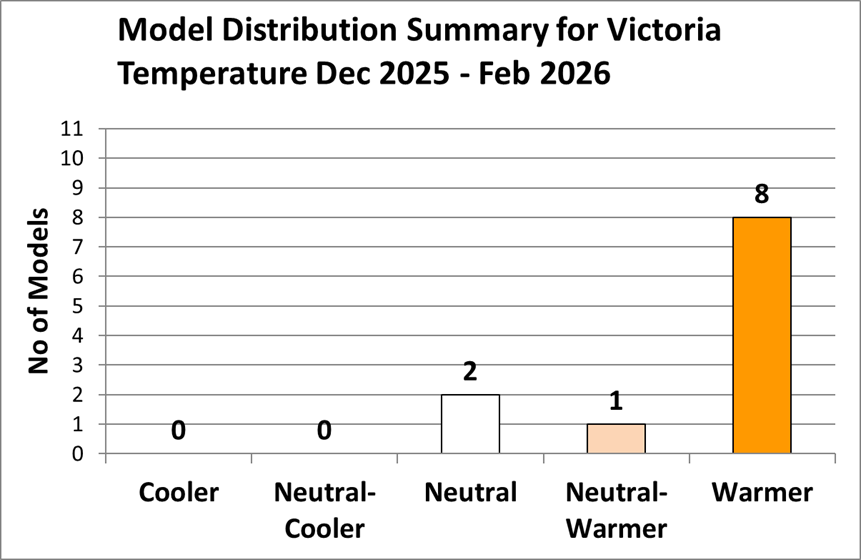
Model distribution summary for the next 4 to 6 months
Predicted rainfall: March to May 2026
Predictions for March to May 2026 Victorian rainfall – the outlook from 9 global model forecasts is neutral for rainfall across Victoria.
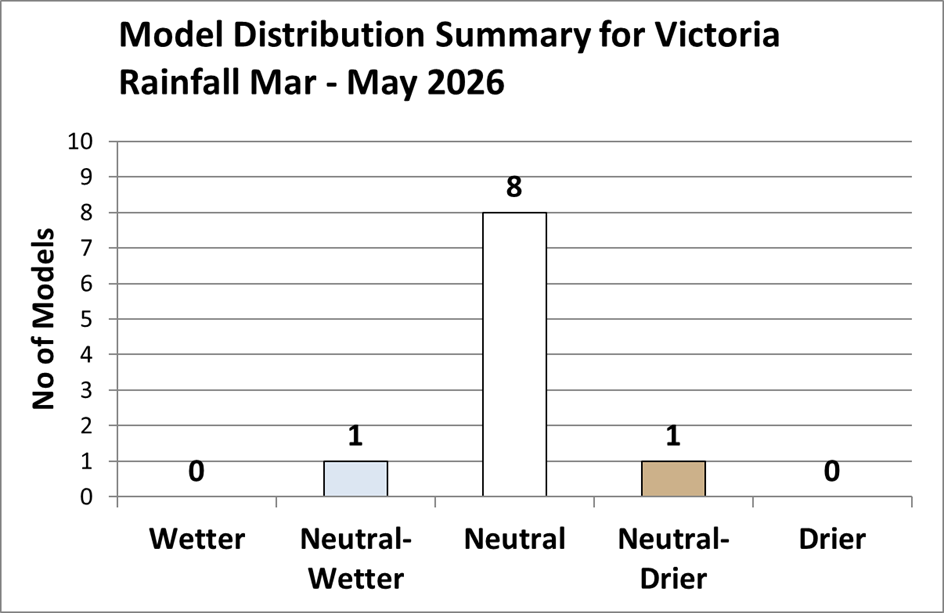
Predicted temperature: March to May 2026
Predictions for March to May 2026 temperature – the outlook from 9 global model forecasts is for likely warmer across Victoria.

Model consensus forecast for the next 6 months
Current outlook (28 November)
Phenomenon | December 2025 – February 2026 | March–May 2026 |
|---|---|---|
Pacific Ocean | Slightly cooler/cooler (La Niña?) | Mixed |
Indian Ocean | Slightly warmer | Normal/slightly warmer |
Rainfall | Neutral | Neutral |
Temperature | Warmer | Warmer |
Previous outlook (10 November)
Phenomenon | November 2025 – January 2026 | February–April 2026 |
|---|---|---|
Pacific Ocean | Cooler (La Niña) | Slightly cooler/normal |
Indian Ocean | Warmer (−IOD) | Slightly warmer/normal |
Rainfall | Wetter/neutral | Neutral (wetter far east) |
Temperature | Warmer | Warmer |
Sea surface temperature (SST) anomalies
During November the central equatorial Pacific Ocean surface remained cooler. The relative oceanic values for NINO3 and NINO3.4 were -0.72 and -0.91oC respectively (30 Nov), close to the weak La Niña threshold of -0.8oC.
The Coral Sea temperature is much warmer as an enhanced moisture source.
The negative Indian Ocean Dipole event is most likely in its decay phase as the Dipole Mode Index has rapidly declined currently at -0.46oC (4 December). The DMI remains just at a -IOD threshold with warmer water off Sumatra, but the water off Africa has normalised or got warmer.
Sea surface temperatures are the key to the world’s rainfall. For more information on how they are measured, maps created and how to read them, check out our eLearn
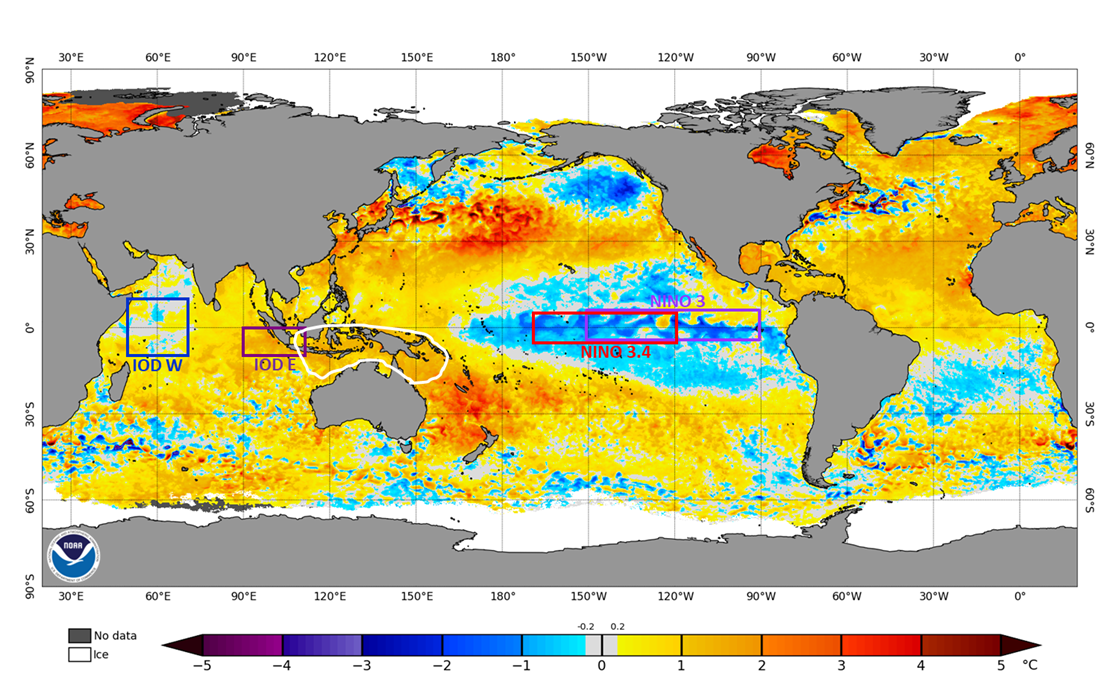
National Oceanic and Atmospheric Administration (NOAA) Coral Reef Watch Daily 5 km SST Anomalies (Version 3.1) 2 December 2025.
Equatorial last 30-day subsea temperature anomalies
Average of 4 November 2025 to 29 November 2025
There is little change to the Pacific Ocean equatorial sub-surface temperatures. A cool anomaly at depth halfway across the Pacific is surfacing to maintain the weak La Niña.
The western Pacific remains warmer at depth being fed by the very warm surface temperatures in the Coral Sea.
The eastern Indian Ocean is very warm to depth as a result of increased downwelling due to the stronger westerly winds into Sumatra.
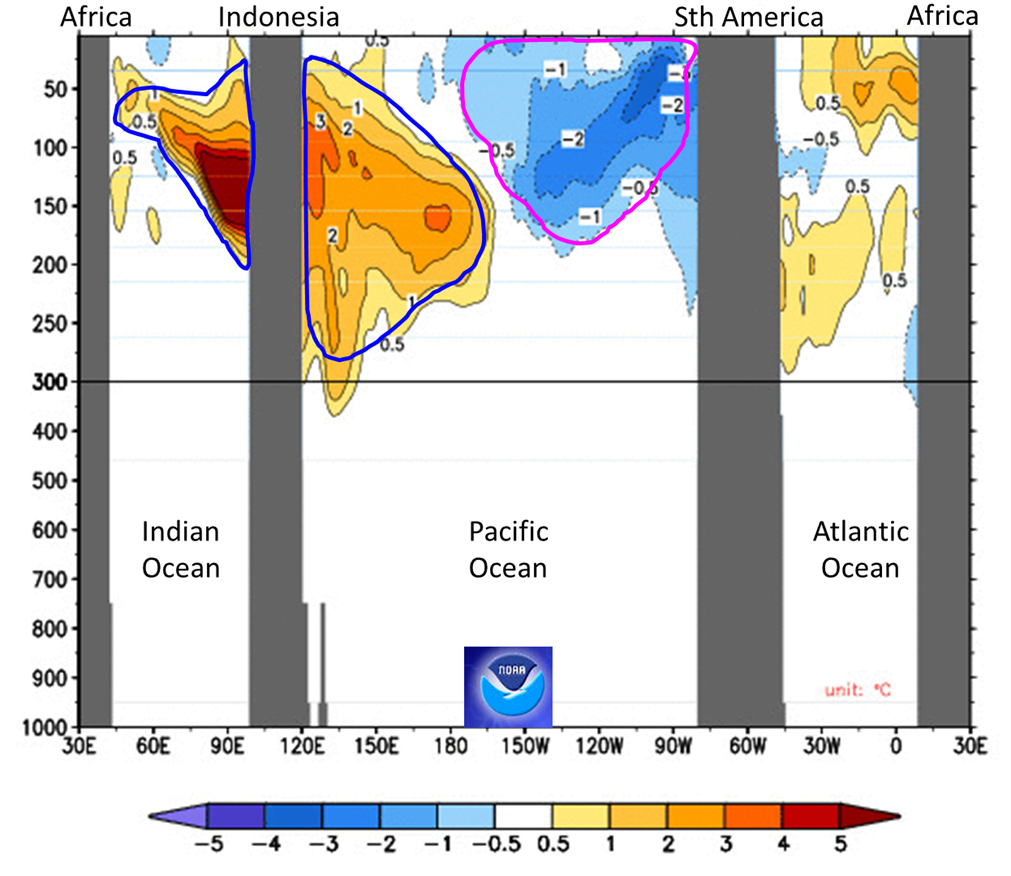
Southern Oscillation Index (SOI)
30-day moving SOI: 1 December 2025
The SOI is the difference in air pressure between Tahiti and Darwin. The pressure has remained lower than normal at Darwin and the SOI in November stayed above La Niña like values of +7.0 to be at +11.6 (as of 1 December).
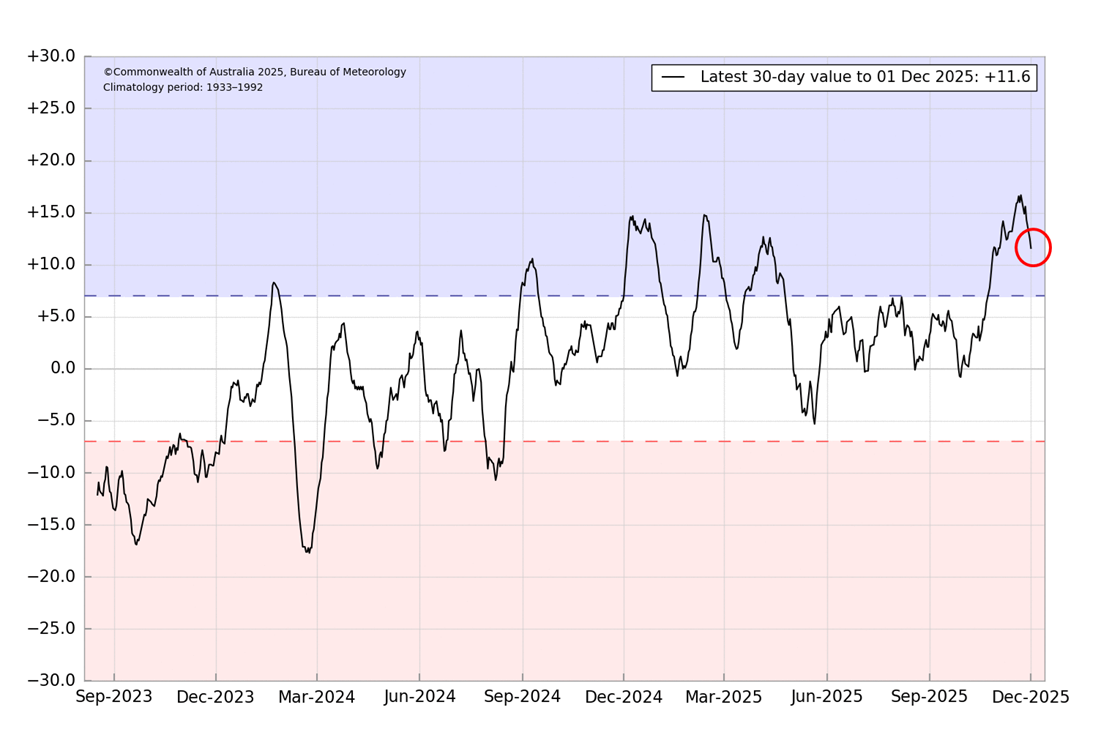
© Copyright Commonwealth of Australia 2025. Bureau of Meteorology. Climatology period 1933–92.
Dipole Mode Index (DMI)
Latest weekly value to 2 November 2025
The DMI is the difference between the temperature of the west and east boxes of the Indian Ocean monitored for the IOD. The DMI has been rapidly decreasing to a weak -IOD value (-0.46oC on 30 December) where the threshold for -IOD is -0.4oC.
It’s likely the -IOD is in its decaying phase as is normal for this time of the year when the northern monsoon season kicks in.
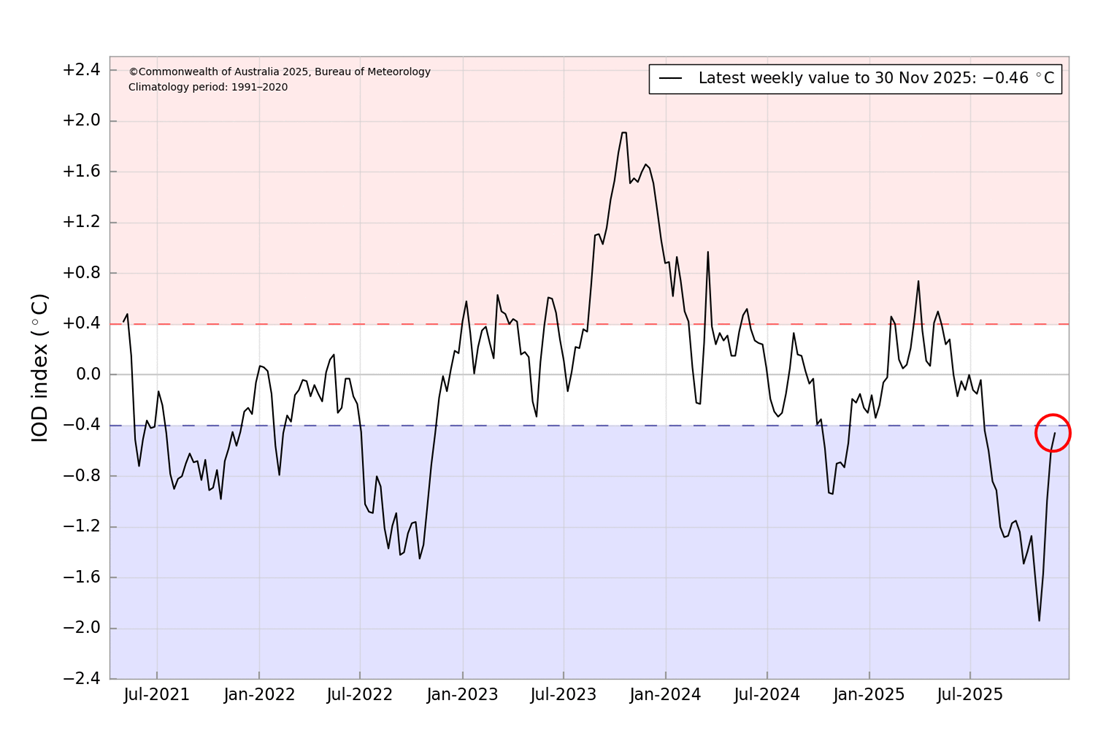
© Copyright Commonwealth of Australia 2025. Bureau of Meteorology.
Pacific Ocean surface wind anomalies
Wind direction and strength anomalies for the last 30 days.
Operational data: Surface winds (m/s) 30-day anomaly for Tuesday 4 November 2025 to Wednesday 3 December 2025.
The trade winds during November were stronger easterly across the western Pacific, helping to keep warmer water in the Coral Sea. Continued stronger easterly winds are a key condition for a functioning La Niña.
Stronger westerly winds along the equator in the Indian Ocean were keeping warmer water piling up off Sumatra, a key feature of a functioning -IOD. In the last weeks these westerlies have relaxed which would be consistent with the -IOD decaying.

(NCEP Operational climatology data: 1985–96, smoothed with 5-day running mean.) Source: NOAA.
World cloudiness anomalies
OLR anomalies: Average of 1 November 2025 to 1 December 2025.
Cloud at the junction of the dateline and equator is slightly less than normal, combined with the greater cloud to the north of Australia this is reminiscent of a La Niña like pattern.
In the Indian Ocean no cloud pattern exists consistent with a -IOD. The lack of cloud is more in keeping with the current phase of the MJO.

Source: Bureau of Meteorology.
Southern Annular Mode (SAM)
AAO: Observed and GFS forecasts
Observations 6 August to 3 December 2025
The Southern Annular Mode (SAM) or Antarctic Oscillation (AAO) spent most of November in weak to moderate negativity. In spring the effect of a -SAM is erratic but this year appears to have increased rainfall south of the Great Divide.
Over summer a -SAM would be expected to dry off far eastern Victoria. A -SAM drying effect on coastal NSW is apparent and consistent with a -SAM at this time of the year.

Source: NOAA
Madden–Julian Oscillation (MJO)
MJO phase diagram for 23 October 2025 to 1 December 2025
In the last 40 days the MJO cloud band spent most of its time to the north of Australia at positions 5 and 6. It has now left the region of rain source influence and is out in the western Pacific at position 7.
The MJO is predicted to circuit across the Pacific and return to position 4 in the middle of the Indian Ocean in the next 30 days. It’s likely that this current phase of the MJO will set off a burst of reversed trade wind in the western Pacific, which could initiate the current La Nina’s demise.
The MJO is a cloud band travelling in an easterly direction just under the equator. It often takes around 40 days to complete a circumnavigation and can be a moisture source when its north of Australia at positions 5 and 6.
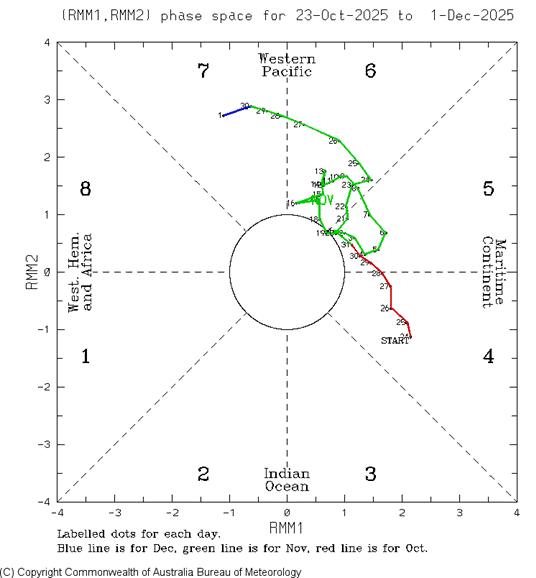
Source: Bureau of Meteorology.
Air pressure
Last 30 days air pressure
Sea level pressure (mb) 30-day mean for: Tuesday 4 November 2025 to Wednesday 3 December 2025.
In the past 30 days the Sub Tropical Ridge of High Pressure (STR) remained weak across southeastern Australia with Victoria in a trough zone between the Indian and south Pacific oceans highs.
The pressure ridge returned south to a more normal latitude centred across Adelaide, allowing an easier tropical moisture pathway

Source: NOAA
Air pressure anomalies
Last 30 days air pressure anomaly
Sea level pressure (mb) 30-day anomaly for: Tuesday 4 November 2025 to Wednesday 3 December 2025.
The Sub Tropical Ridge was lower in pressure over Australia during November. This was due to numerous low pressure and frontal systems passing through.
Lower pressure at Darwin and normal at Tahiti is why the SOI is positive. Lower pressure at Darwin makes it easier to get tropical moisture down from the north.
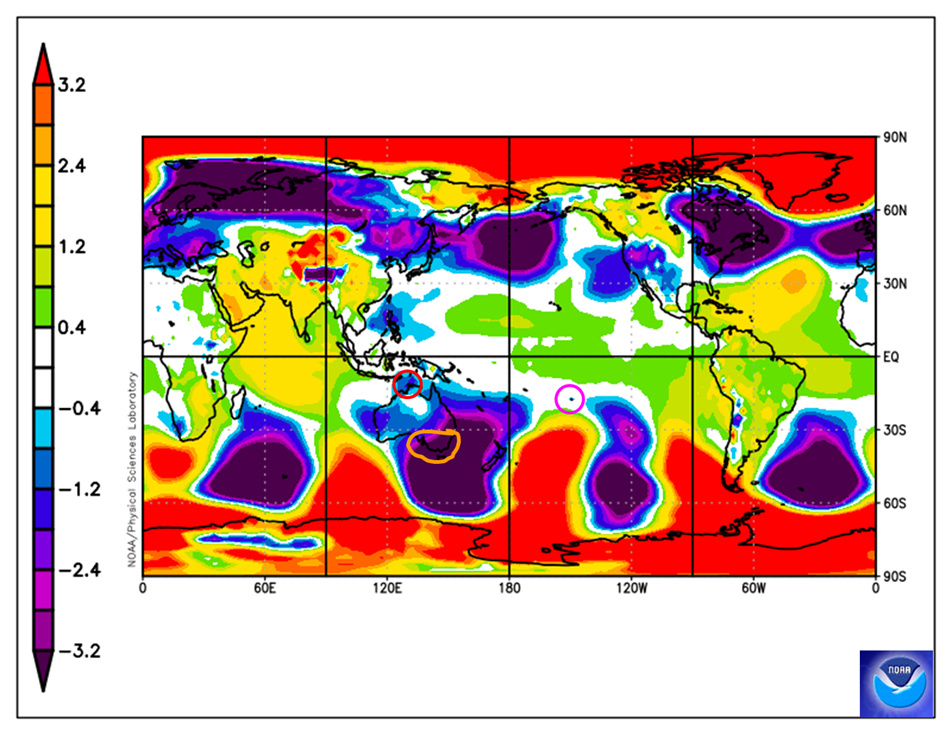
(NCEP Operational climatology data: 1985–96, smoothed with 5-day running mean.) Source: NOAA
Climate definitions
Read a list of climate acronyms and explanations.
Modelled climate and ocean predictions for Victoria from November 2025-run models
Twelve climate models show their predictions for the next 6 months for the Pacific Ocean, Indian Ocean, rainfall and temperature for Victoria.
View a colour-coded version of this table ![]() [MS Word Document - 77.0 KB]
[MS Word Document - 77.0 KB]
Our e-learning module How to read the Fast Break table explains this table.
Four coupled global circulation model forecasts
Phenomenon | System 5 | ACCESS-S | SINTEX-F | CFSv2 |
|---|---|---|---|---|
Month of run | November | November | November | November |
Forecast months* | DJF | DJF | DJF | DJF |
Rainfall skill DJF | Low | Moderate / Low far SW Coast | – | Low |
Summer Pacific Ocean NINO3.4 | Slightly cool | Slightly cool (weak La Niña) | Slightly cool | Slightly cool |
Summer eastern | Slightly warm | Slightly warm | Slightly warm | Warm (−IOD) |
Summer rainfall | Neutral, slightly wetter far W, far E | Neutral | Neutral | Neutral, slightly wetter far E |
Summer temperature | Neutral | Warmer, neutral far E | Slightly warmer | Neutral |
Forecast months* | MAM | FMA | MAM | MAM |
Autumn Pacific Ocean NINO3.4 | Slightly warm | Normal | Slightly warm | Normal |
Autumn eastern | Slightly warm | Normal | Normal | Normal |
Autumn rainfall | Neutral | Neutral / slightly drier E Gipps | Neutral | Neutral, slightly wetter far E |
Autumn temperature | Neutral | Warmer | Slightly warmer | Slightly warmer |
Further info | Operational | Operational | Experimental | Operational |
Four coupled global circulation model forecasts
Phenomenon | GEOS-S2S | EPS | CSM1.1m | GloSea5 |
|---|---|---|---|---|
Month of run | November | November | November | November |
Forecast months* | DJF | DJF | DJF | DJF |
Rainfall skill DJF | Moderate | Low W / Moderate E | Moderate | Low W / Moderate E |
Spring Pacific Ocean NINO3.4 | Cool (weak La Niña) | Slightly cool | Cool (weak La Niña) | Cool (weak La Niña) |
Spring eastern | Slightly warm | Normal | Slightly warm | Slightly warm |
Spring rainfall | Neutral W / Slightly drier E | Neutral W / Slightly drier E | Slightly wetter, neutral far E | Neutral, slightly wetter far E |
Spring temperature | Warmer | Warmer | Warmer | Slightly warmer |
Forecast months* | MAM | – | MAM | FMA |
Summer Pacific Ocean NINO3.4 | Warm (El Niño) | – | Slightly cool | Slightly cool |
Summer eastern | Slightly warm | – | Normal | Slightly warm |
Summer rainfall | Neutral W, slightly wetter E | – | Neutral | Neutral, slightly wetter far E |
Summer temperature | Slightly warmer, neutral far W | – | Warmer | Slightly warmer, warmer coast |
Further info | Experimental | Experimental | Operational | Operational |
Three ensembles and a statistical model forecast
Phenomenon | NMME | C3S | MME | SOI phase |
|---|---|---|---|---|
Month of run | November | November | November | November |
Forecast months* | DJF | DJF | DJF | DJF |
Rainfall skill DJF | Moderate | – | – | – |
Spring Pacific Ocean NINO3.4 | Slightly cool | Cool (weak La Niña) | Slightly cool | SOI Positive |
Spring eastern | Warm (−IOD) | Slightly warm | Normal | – |
Spring rainfall | Neutral / Slightly drier SW | Neutral, slightly wetter far E | Neutral | Neutral W, slightly wetter E |
Spring temperature | Warmer | Neutral / slightly warmer S, far W | Slightly warmer | – |
Forecast months* | MAM | FMA | MAM | – |
Summer Pacific Ocean NINO3.4 | Slightly warm | Normal | Slightly warm | – |
Summer eastern | Normal | Slightly warm | Normal | – |
Summer rainfall | Neutral N/ Slightly drier S | Neutral, slightly wetter far E | Neutral | – |
Summer temperature | Slightly warmer | Neutral / slightly warmer NE, far W | Slightly warmer | – |
Further info | Experimental | Experimental; | Experimental; | 5-phase system based on previous 2 months SOI |
*DJF = December, January, February FMA = February, March, April MAM = March, April, May
Image references
Original images used in this document are sourced from the Bureau of Meteorology under a Creative Commons 3.0 licence and from the NOAA which has a public domain policy. Annotations highlighting areas of interest have been added by Dale Grey.